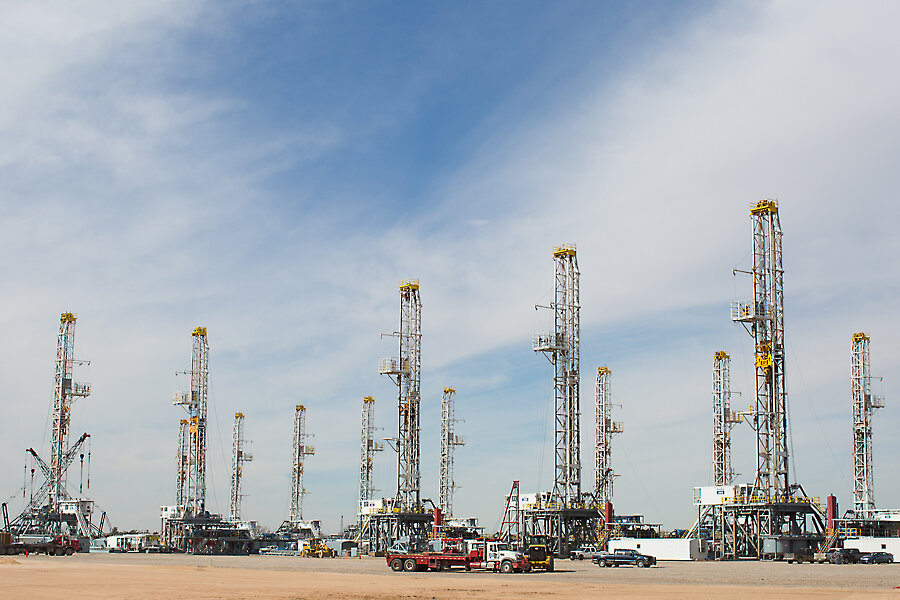Is OPEC winning an oil price war against the US?
Loading...
Demand for oil from the Organization of the Petroleum Exporting Countries is set to rise this year, while growth in US oil production will slow as American energy firms cut back on drilling.
That’s the conclusion of the latest monthly oil report from OPEC, the 12-member oil cartel that accounts for about 40 percent of the world’s oil production. If the forecasts prove true, it suggests that OPEC is winning an undeclared price war against a growing rival: namely, the US.
But it may be too early to declare a victor – and too simplistic to frame a complex global market as a bilateral race for dominance. US producers may be cutting back on jobs and active drilling rigs, but they’re finding ways to get more for less, and won’t soon walk away from their most productive wells.
“The rig count doesn’t tell you the whole story,” Brenda Shaffer, a professor at Georgetown University’s Center for Eurasian, Russian and East European Studies in Washington, says in a telephone interview. “It’s an indicator that’s important, but it’s not a direct translation [to production levels]”
As the price of oil has plummeted by more than half since last June, OPEC has taken the unexpected stance of maintaining its production levels and letting prices fall. Most analysts see it as an attempt to put pressure on US producers who have taken on large amounts of debt and need higher oil prices to justify drilling. The price drop has already spurred a series of job cuts and idled rigs in the US oil industry. Monday’s report from OPEC is the latest indication that OPEC’s strategy to protect oil markets from rising competitors appears to be working – for now, at least.
“Non-OPEC supply growth in 2015 is expected to experience increases in all quarters of 2015 on a [year-on-year] basis, but at a slower pace,” OPEC wrote in its report, released Monday. “The main factors for the lower growth prediction in 2015 are price expectations, a declining number of active rigs in North America, a decrease in drilling permits in the US and a reduction in the 2015 spending plans of international oil companies.”
Total US petroleum production will average average 13.64 million barrels per day in 2015, according to OPEC. That’s still an increase of 820,000 barrels a day over 2014, but it’s 130,000 barrels less than what OPEC had anticipated last month. In other words, OPEC is keeping track of all the recent cutbacks in US oil, and assuming that supply growth will slow as a result.
Last week, the number of drilling rigs actively searching for oil in the US dropped by 83 to 1,140, according to data from Baker Hughes, an oil-field services company. That’s the lowest number it's been since December 2011.
But even OPEC admits that dropping rig counts won’t lead to a drop in US oil production anytime soon. It cites two reasons for continued (albeit slower) growth:
“The first is an increase in the share of horizontal well drilling compared with vertical and directional well drilling employed in most plays’ sweet spots in the current circumstances, while the second is the time lag between drilling and well completion, which is at least a three-month period.”
In other words, the number of US rigs may be falling, but the amount of area they cover, and the quality of those areas, is not.
What’s this all mean for oil prices? Crude prices have rebounded over the past week, suggesting the oil price collapse may be coming to an end or even reversing. In its report, OPEC slightly increased its 2015 forecast for oil demand, predicting that cheap oil will increase consumption most notably in the US. That, in theory, would put upward pressure on prices. Brent crude oil – the global benchmark – was trading up 1.2 percent to $59.39 midday Monday, in response to the report.
Still, many believe the market remains oversupplied, and that it will be a while – if ever – before prices near triple-digits again.
“The fundamentals don’t indicate a shift,” Ms. Shaffer says. “[Oil] storage is up. Non-oil commodities demand is down. Economic growth in markets is down. In the big picture, you wouldn’t expect the price to go up in these conditions.... But oil prices are about cycles, so of course at some point prices are going up."






